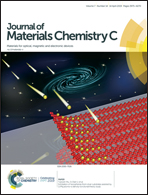Nanothermometers based on lanthanide incorporated Periodic Mesoporous Organosilica†
Abstract
Nano-sized (50–70 nm) Periodic Mesoporous Organosilica (PMO) was synthesized using 5% N,N-bis(trimethoxysilylpropyl)-2,6-pyridine dicarboxamide and 95% tetraethyl orthosilicate and was further grafted with appropriate ratios of Eu3+ and Tb3+ or Sm3+ and Tb3+ chloride salts to develop novel ratiometric temperature sensors. The lanthanide ions coordinated to the pyridine dicarboxoamide ligands. To enhance the luminescence of these materials 1,10-phenanthroline was used as a co-ligand in the grafting synthesis. The developed series of hybrid LnPMO materials was analyzed in detail for their temperature dependent luminescence properties. The changes in the emission spectra as well as decay times were recorded. The latter allowed a detailed investigation of the energy transfer mechanism between the two lanthanide ions. The EuxTbxDPA-PMO materials showed good sensing capability in the 260–460 K range. The SmxTbxDPA-PMO materials showed very good sensing capability in the 280–460 K range. This is a unique study, where the possibility of employing PMO materials for optical thermometry is investigated.



 Please wait while we load your content...
Please wait while we load your content...